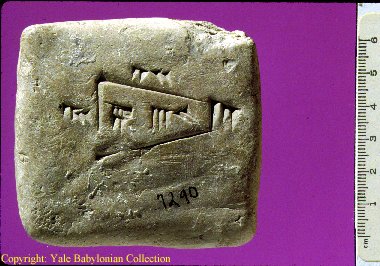



The tablet on the left, YBC 7302, shows a diagram of a circle with the numbers 3, 9 and 45. The 45 represents the area of the circle, while 3 is the circumference. The usual rule for computing the area of a circle in Old Babylonian mathematics is A=C^2/12, or rather A=5C^2 as 5 is the reciprocal of 12.
The second tablet shows a diagram of a trapezoid, a very common figure in Old Babylonian mathematics, again with numbers representing the lengths of sides and the area. The base and side are inscribed with 2,20, the top with 2. The area is obtained by a standard procedure in Old Babylonian mathematics of 5,3,20 = 2,20x(2,20+2)x30.
Both of these tablets were originally published by Neugebauer and Sachs in Mathematical Cuneiform Texts.
I thank Professor W.W. Hallo for permission to use the images of the tablets.
Go to Mesopotamian Mathematics.
Last modified: 6 June 2001
Duncan J. Melville